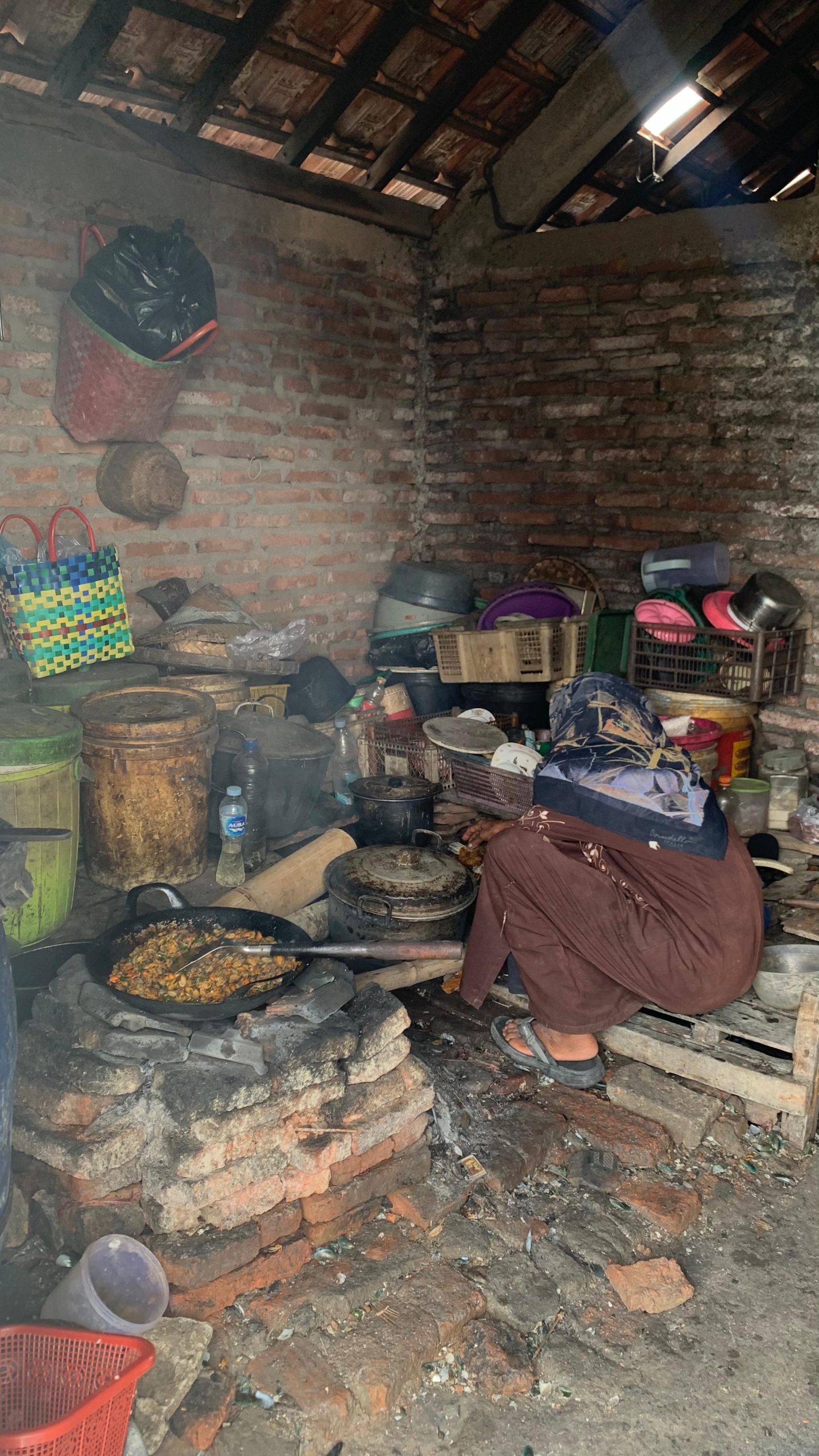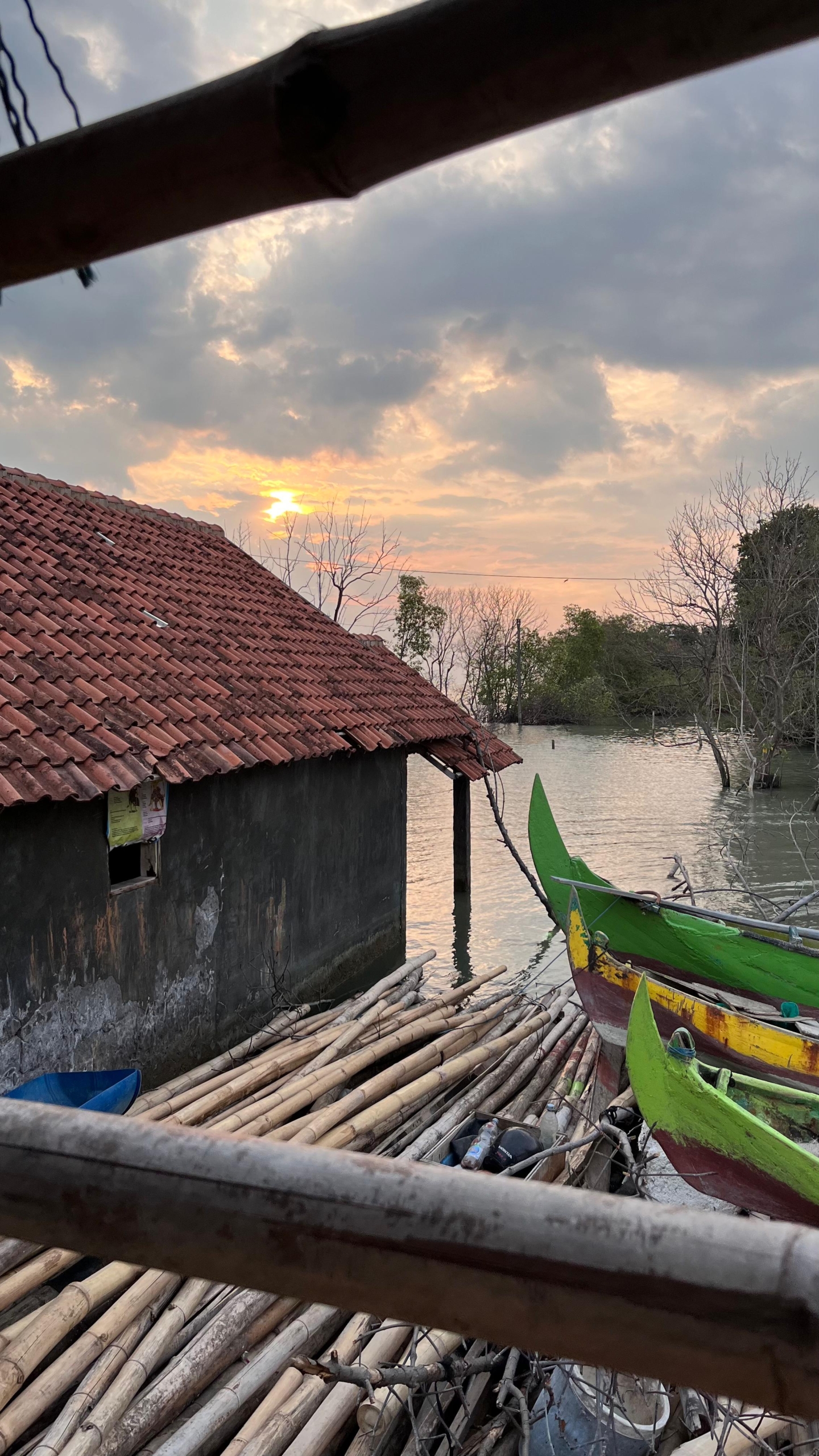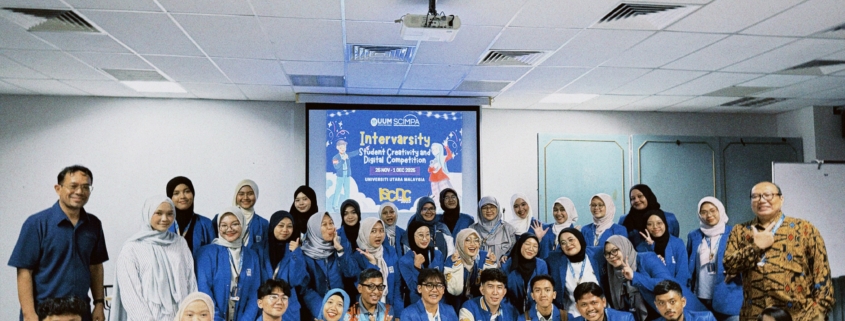Catatan perjalanan ke Demak beberapa bulan lalu begitu memberi makna mendalam, sembilan jam bertahan di rumah Mak Jah bukan perkara yang sederhana. Artinya, setangguh apa perempuan ini hingga mampu bertahan hampir seperempat abad dalam genangan laut?
Perjalanan dari Kaliurang, Yogyakarta dimulai pada Jumat, 29 Agustus 2025 sekitar pukul 3.30 WIB. Tak ada kendala berarti, jalanan Kopeng menawarkan udara segar membuat rombongan kami membuka lebar-lebar kaca minibus. Seperti biasa, untuk mengisi amunisi kami memilih sarapan soto Boyolali di sepanjang jalan Salatiga. Soto dengan hint manis adalah pilihan yang tepat.
Kami memilih masuk tol Bawen untuk mempersingkat perjalanan, pukul 08.00 WIB sampai di Kecamatan Sayung. Riuh dengan truk-truk pengangkut pasir, mereka berjalan bertubi-tubi memenuhi jalanan tanah berdebu. Kami mengamatinya, mengambil gambar, hingga merekam aktivitas lalu lalang. Sejam kemudian, ada telepon masuk. Rupanya kami sudah ditunggu untuk segera menyebrang menuju rumah Mak Jah.
Perahu kecil dengan tenaga diesel ini adalah satu-satunya alat transportasi menuju rumah Mak Jah, satu-satunya rumah yang masih berpenghuni. Sekitar lima belas menit berlalu, tangan Mak Jah melambai bersambut. Satu persatu dari kami turun menghampiri. Pintu dapur yang beralih fungsi menjadi pintu utama kini akrab dijajaki tamu dengan berbagai latar belakang dan tujuan.
“Saiki aku wis gak kerja mas, gak jajak rob naik terus [sekarang aku sudah tidak bekerja mas, tidak bisa menjajaki-hampir tenggelam karena rob naik terus],” ucap Mak Jah setelah mempersilakan kami duduk di ruang tengah.
“Sekarang yang kerja (panen kerang) suami dan anak pertama,” tambahnya.
“Permintaan bibit [mangrove] juga menurun karena jalan susah,” keluhnya lagi.
Ia menatap seluruh sudut rumahnya yang semakin rendah akibat lantai yang terus ditinggikan. “Rob tidak terprediksi. Sekarang tidak bisa dipastikan, dulu bisanya bulan-bulan tua. Pengaruh tol, ombak ngeri. Ini ombak paling besar. Karena tol, [ombak] ngglebak rene, dulu menyebar,” ucapnya mengurai masalah.
Mak Jah mempertebal realita yang kami lihat, bercerita seperti mencurahkan keluh kesah dengan teman. Kami tak banyak bertanya, mendengar dan menanggapinya saja. Setelah itu ia kembali ke dapur memasak kerang hasil tangkapan dan menanak nasi di pawon.
Solastalgia dan Krisis Iklim yang Membelenggu
Jika berfikir dengan logika sederhana, Mak Jah dan keluarganya bisa saja turut serta dalam program relokasi pemerintah. Namun, hal ini cukup rumit. Keinginannya menjaga alam begitu kuat. Ia konsisten menanam mangrove lebih dari 20 tahun, meski demikian perasaan getir atas krisis iklim tak dapat dipungkiri. Berdasarkan hasil riset yang dilakukan Iven Sumardiyantoro, peneliti yang sejak tahun 2023 aktif dalam kerja-kerja observasi dan dokumentasi telah menganalisis kondisi tersebut dengan pemaknaan solastalgia.
“Meskipun di tingkat global banyak peneliti telah menjelaskan kondisi solastalgia dalam berbagai konteks dan peristiwa, peneliti di Indonesia belum banyak menggunakan konsep tersebut. Faktanya, Indonesia merupakan salah satu negara dengan tingkat risiko bencana tertinggi di dunia, baik akibat bencana alam maupun kebijakan yang buruk,” jelas Iven Sumardiyantoro.

Kondisi dapur rumah Mak Jah, di Sayung Demak. Dok: Prodi Ilmu Komunikasi UII
Solastagia merupakan reaksi kecemasan akibat perubahan iklim, istilah ini diciptakan oleh Glenn Albrecht seorang filsuf lingkungan asal Australia. Berbeda dengan nostalgia yang merupakan kerinduan rumah masa lalu dengan kenangan dan membahagikan, solastalgia menjelaskan kondisi mental atau penyakit yang dialami oleh orag-orang korban bencana.
“Solastalgia adalah rasa sakit atau penyakit yang disebabkan oleh kehilangan atau ketiadaan kenyamanan dan rasa isolasi yang terkait dengan kondisi saat ini dari rumah dan wilayah,” jelas Iven.
Sebelumnya Mak Jah memiliki memori baik tentang kampungnya (Bedono). Namun kini rusak karena iklim, dampak banjir rob dirasakan sejak awal tahun 2000-an, puncaknya tahun 2015 penurunan tanah semakin signifikan. Turun sekitar 15-20 cm per tahun. Dari hasil risetnya, Iven menyebut warga mulai meninggalkan wilayah tersebut sejak tahun 2006.
Riset yang dilakukan Iven menghasilkan tiga analisis yang kompleks, pertama menyoroti perubahan iklim menyebabkan perubahan mata pencaharian, bertahan hidup di desa tenggelam, dan gejala solastalgia pada masyarakat.
Lahan pertanian seluruhnya tenggelam, terendam air laut sehingga berdampak pada mata pencaharian. Dari petani beralih menjadi nelayan atau budaya agraris ke pesisir.
“Dulu saya petani, lalu nelayan. Nelayan tidak cukup (penghasilan), saya punya ide untuk membuat (benih mangrove)”, ujar Mak Jah.
Itulah cara Mak Jah bertahan, namun hatinya ternyata menyimpan duka, kehilangan kenyamanan, hingga ikatan dengan rumah dan lingkungan yang rusak. Rumahnya berubah, dulu memberikan kenyamanan kini sebaliknya kesedihan dan kepahita.
“Dan saya sering kebanjiran saat tidur di lantai panggung, terutama saat angin kencang. Pada malam hari, banjir pasang tiba-tiba datang dan saya berkata kepada keluarga saya, ‘Hei, basah.. bangun. bangun’. Dan saya terkejut karena semua bantal dan tikar tidur basah”, ucap Mak Jah.

Kondisi sekitar rumah Mak Jah, Sayung Demak. Dok: Prodi Ilmu Komunikasi UII
Keteguhan Mak Jah dilirik oleh pemerintah dan berbagai organisasi lain. Deretan piagam penghargaan tertempel pada dinding yang tinggal setengah. Penghargaan itu antara lain: Pemerintah provinsi Jawa Tengah – Dinas Lingkungan Hidup dan Kehutanan (2021) pengusulan calon penerimaan penghargaan kalpataru tingkat kecamatan provinsi. (Usulan kategori perintis lingkungan, penyelamat lingkungan, pengabdi lingkungan, pembina lingkungan).
Kedua, Teladan Cinta pada Alam (Amartha &amartha.org) – Amartha Local Heroes. Ketiga, Piagam Penghargaan Peringatan Hari Kartini – atas jasanya di bidang lingkungan hidup dalam rangka peringatan hari Kartini 2023. Organisasi Aksi Solidaritas Era Kabinet Indonesia Maju. Dan terakhir, Penghargaan Kalpataru tahun 2021, sebagai perintis, pengabdi, penyelamat, dan pembina lingkungan hidup tingkat Provinsi.
Upaya Konservasi Lingkungan dengan Memahami Risk Communication
Solastalgia yang dirasakan Mak Jah dan korban lainnya mungkin saja terabaikan. Tak ada penanganan khusus. Korban tak diajak berkomunikasi dengan hati ke hati. Lantas bagaimana menyelesaikan persoalan ini?
Sebagai informasi krisis iklim di Demak, Jawa Tengah terjadi karena faktor alam dan aktivitas manusia. Berbagai pembangunan yang tak memperhatikan dampak lingkungan cukup masif dilakukan. dari pembangunan pelabuhan hingga jalan tol.
Akademisi Komunikasi Lingkungan dari UII, Muzayin Nazaruddin mencoba mengurai bagaimana memahami alasan apa yang membuat korban climate change enggan direlokasi. Jawaban ini memiliki benang merah atas kondisi mental solastalgia. Mulai dengan memahami makna risiko dan dampak climate change. Ia menyebut jika risiko dari climate change, tak sederhana layaknya kalkulasi objektif tentang apa yang berbahaya dan tidak. Pada masyarakat terdampak, risiko adalah persepsi yang dirasakan. Hal ini berdampak tak selaras pada pengambil kebijakan.
Kecenderungan masyarakat adalah berkelompok, mereka ingin terus terhubung. Relokasi dapat dilakukan dengan memperhatikan berbagai aspek, seperti administrasi yang sederhana hingga biaya pembangunan yang ideal.
“Climate change harus diantisipasi atau masuk dalam agenda pembangunan, sayangnya pemerintah Indonesia belum punya cukup agenda menghadapi climate change ini. Mitigasinya belum jelas,” ujarnya.
Dari pengamatannya, saat ini banyak LSM, masyarakat sipil, dan organisasi yang turut membantu sayangnya bersifat karitatif atau tambal sulam. Menurutnya, pemerintah memfasilitasi berbagai pihak duduk bersama, ngobrol bersama termasuk bersama warga mereka inginnya bagaimana. Kalau mereka mau bertahan di sana harus bagaimana kalau mau dipindahkan dimana dan bagaimana. Harus ada visi jangka panjang.
“Artinya ketika pemerintah membangun kebijakan berbasis risiko harusnya mempertimbangkan apa sih yang menurut warga menjadi risiko,” tandasnya.
Penulis: Meigitaria Sanita













